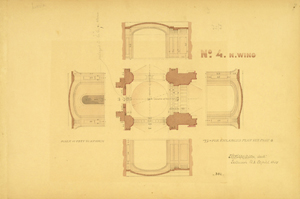
![]()

| By the time the first shots were fired at Fort Sumter in April 1861, the United States Capitol building had been under construction for more than a decade. The new Senate and House wings remained unfinished; and the magnificent dome rose to less than half its final height. The Great Civil War that would test whether the nation would survive was a trial for the building itself, and also its long-suffering Philadelphia architect, Thomas Ustick Walter (1804-1887). Based on original drawings, photographs, prints and the architect’s own diaries and letters, this exhibition focuses on the architectural, engineering, political, artistic, military and family challenges Walter faced during the war years. | |
 |
Thomas
Ustick Walter Salted Paper Print c. 1861 Walter Collection, The Athenaeum of Philadelphia |
| United States
Capitol From the East
Reproduction from Daguerreotype 1846 This is how the Capitol looked when Walter was first hired to design the extension wings. The low saucer-shaped plaster & wood dome was completed in 1823 by Boston architect Charles Bulfinch (1763-1844). Courtesy of The Library of Congress |
 |
 |
|
|
United States Capitol Approved Extension Design Thomas U. Walter, Architect Ink, Wash & Watercolor on Whatman Paper 1851 On June, 10, 1851, President Millard Fillmore approved Walter’s design for the extension wings, one for the House of Representatives and one for the Senate, each with three porticos and each connected to the original capitol structure with narrow corridors. The cornerstone of the new work was laid on July 4, 1851, the 75th anniversary of the Declaration of Independence. Walter Collection, The Athenaeum of Philadelphia |
|
 |
Plan and Elevation of Room #4, North
Wing, Extension of U. S. Capitol Thomas U. Walter, Architect Ink, Wash and Watercolor on Whatman Paper 1854 Walter Collection, The Athenaeum of Philadelphia |
| Plan of Principal Story, North Wing,
Extension of U. S. Capitol Thomas U. Walter, Architect Ink, Wash and Watercolor on Whatman Paper May 12, 1854 Walter Collection, The Athenaeum of Philadelphia |
 |
|
|
|
 |
Column Shaft Installation North Connecting Corridor, U. S. Capitol Salted Paper Print November 26, 1860 In this posed ceremonial photograph is seen the architect, (with hand on hip) and Senator Jefferson Davis. Within a few weeks Davis had left the Senate to become the President of the Confederate States of America. Walter Collection, The Athenaeum of Philadelphia |
|
|
|
| Inauguration of Abraham Lincoln
East Front of United States Capitol Mounted Albumen Print March 4, 1861 Walter Collection, The Athenaeum of Philadelphia |
 |
 |
|
 |
|
 |
Copyright © 2012 The Athenaeum of Philadelphia